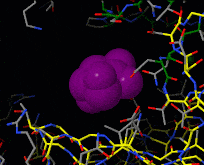Induced fit
From Proteopedia
(Difference between revisions)
(polishing) |
|||
| Line 1: | Line 1: | ||
| - | + | [[Induced fit]] describes a conformational change in a protein when it binds a ligand, in contrast to a lock-and-key model of ligand binding. A classical example of induced fit is binding of glucose to hexokinase, depicted in a morph between [[3o8m]] and [[3o80]] below. | |
| - | + | ||
| + | [[Image:Induced fit.gif]] | ||
| + | |||
| + | ==History of the concept== | ||
| + | |||
| + | Induced fit was suggested by Koshland in 1958 <ref> DOI:10.1002/anie.199423751</ref>, providing an alternative to the lock-and-key binding model that Emil Fischer proposed in 1899 <ref>DOI:10.1002/cber.18940270364</ref>. | ||
| + | |||
| + | ==Interactive examples== | ||
| + | <StructureSection load='' size='350' side='right' caption='' scene=''> | ||
| + | |||
| + | In preparation. | ||
| + | |||
| + | </StructureSection> | ||
| + | |||
==See Also== | ==See Also== | ||
*A morph of induced fit when [[Avian_Influenza_Neuraminidase%2C_Tamiflu_and_Relenza#Tamiflu_Binds_to_N1_by_Induced_Fit|Tamiflu binds to Neuraminidase]]. | *A morph of induced fit when [[Avian_Influenza_Neuraminidase%2C_Tamiflu_and_Relenza#Tamiflu_Binds_to_N1_by_Induced_Fit|Tamiflu binds to Neuraminidase]]. | ||
| + | |||
| + | <references/> | ||
Revision as of 15:24, 13 April 2021
Induced fit describes a conformational change in a protein when it binds a ligand, in contrast to a lock-and-key model of ligand binding. A classical example of induced fit is binding of glucose to hexokinase, depicted in a morph between 3o8m and 3o80 below.
History of the concept
Induced fit was suggested by Koshland in 1958 [1], providing an alternative to the lock-and-key binding model that Emil Fischer proposed in 1899 [2].
Interactive examples
| |||||||||||
See Also
- A morph of induced fit when Tamiflu binds to Neuraminidase.

